5 common defects of Bluetooth speakers and how to test them

Bluetooth speakers are a great way to enjoy music without the need for wall outlets and tangled wires. Besides, Bluetooth speakers can be helpful when one wants to avoid using headphones while streaming shows and movies or playing video games. Despite their convenience, these speakers have a few problems and defects. But most of these can be easily tested and dealt with at home. Here are some common defects of Bluetooth speakers and ways to fix them.
1. Low sensitivity of speakers
Often, this is a common defect that users discover after bringing home a brand-new pair of Bluetooth speakers. Speaker sensitivity or efficiency indicates how much power is required to run the device. In technical terms, it measures how much sound the speaker can produce with one watt of electricity through another device known as an amplifier. The amount that results from this is generally determined in decibels or dB. This means a speaker’s sound will be louder if its sensitivity rating is higher.
Usually, an efficient Bluetooth speaker will not need much power to increase the volume of sound slightly. However, if the speaker is defective, it will produce low volumes of sounds even when it is completely charged. In such situations, the speakers will stop working after some time.
How to test speaker sensitivity : An easy way to check the sensitivity of Bluetooth speakers is to use free apps and software that can be installed on a personal computer or smartphone. These apps and software are tools that provide information such as impulse response, frequency response, and other details that can help know the speaker’s sensitivity. Another method is to use a microphone and sound level meter to measure the level of sound that comes out of the speakers. This will indicate the sensitivity of the speakers.
2. Bad Bluetooth signal strength
It is quite normal to have signal disruptions. This usually happens when there are obstructions, such as a shelf, door, or a wall between the Bluetooth speaker and the device, which is the audio source. However, poor signal strength is a common complaint of many Bluetooth speaker users. Due to this, the speakers cannot connect to the audio source completely. This results in the volume fluctuating a lot between high and low. Often, the audio completely stops coming out from the speaker. Many users often call this as experiencing “spotiness” in the sound quality of the speakers.
How to test the signal strength of Bluetooth speakers : This can be done easily without using expensive equipment. Simply download one of the many free software that monitors the signal strength of Bluetooth devices. These usually give an accurate reading of signal strength.
3. Poor phone call connection
Sometimes, users find out that their call disconnects whenever they try to answer their phone with Bluetooth speakers. This usually happens with speakers installed in a car. The abrupt disconnection is usually because the phone and the speakers have trouble connecting. Usually, the problem might lie with the software of the phone. So, updating the software can quickly solve the problem of poor phone call connection.
How to test phone call connection : It is quite simple to test a phone call connection with Bluetooth speakers. Just pair a phone with a workable connection with the Bluetooth speaker. Once both devices are connected, call the Bluetooth-paired phone using another phone. Once the call is received on the paired phone, any audio that has been previously playing through the Bluetooth speaker should be automatically turned down. Instead, the ringtone of the phone should be audible through the speaker. Once this happens, press the button on the speaker controls to answer the call. If one can take the call through the speaker, this means that the phone call connection is working.
4. Issues with speaker frequency
The frequency range of human hearing ranges between 20 Hz and 20,000 Hz. Most speakers usually produce sounds that have a frequency range between 120Hz and 22,000Hz. However, if the frequency of the sound produced by the Bluetooth speakers goes too low or too high, a user will be unable to hear it. Sometimes, frequency problems cause a speaker to produce a static noise that sounds like audible buzzing or vibration. This is another fairly common defect of Bluetooth speakers.
How to test speaker frequency: While other defects of Bluetooth speakers can be easily tested with software and apps, speaker frequency testing generally requires a special set of tools and equipment. Therefore, this is often done by professionals. They use a frequency response tester to test the speakers’ frequency range. In addition, the tester is used to monitor whether any buzzing or vibration is produced when the speaker is in operation.
If looking for a simpler DIY way to test speaker frequency, one can use several speaker test videos and audio clips available for free online. Simply play these sounds through the Bluetooth speaker and listen for various responses. This may give a fairly good idea of the speaker’s frequency.
5. Rattling noise coming from the speaker
This defect usually occurs when internal parts of the speaker have become loose. Most of the time, this is a manufacturing defect. Sometimes, damage during transportation may also cause parts of the speaker to fall out. This can easily cause a rattling noise when the speaker is powered on. Often, this can also be caused by dust, debris, and foreign objects getting inside the speaker.
How to test for rattling: Shake the speaker when not connected to a power source and listen for any parts that may have come loose. Another way is to open up the speaker and check for loose parts and debris that may cause the rattling noise.

